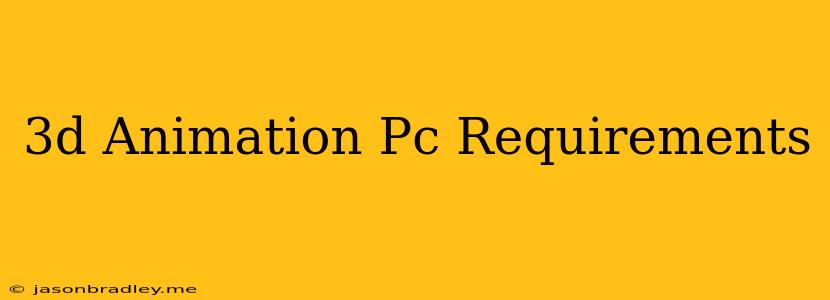3D Animation PC Requirements: A Guide to Building the Right Rig
3D animation is a demanding process that requires powerful hardware to run smoothly. From modeling and texturing to rendering and compositing, each stage requires significant processing power, memory, and storage. This guide will help you understand the key PC components that influence 3D animation performance and how to build a rig that meets your needs.
1. Processor (CPU)
The CPU is the brain of your computer, responsible for executing all the calculations and instructions needed for 3D animation software.
What to look for:
- Core count: More cores generally mean better performance, especially when working with complex scenes and heavy simulations.
- Clock speed: A higher clock speed translates to faster processing speeds.
- Cache: Larger cache sizes can improve performance by storing frequently accessed data.
Recommended CPU:
For entry-level animation, a 6-core CPU with a clock speed of at least 3.5 GHz is a good starting point. For professional use, an 8-core or higher CPU with a clock speed of 4 GHz or more is recommended.
2. Graphics Processing Unit (GPU)
The GPU is crucial for rendering 3D graphics. It handles the complex calculations involved in creating realistic images.
What to look for:
- Memory: A larger amount of VRAM (Video Random Access Memory) allows the GPU to store more textures and render higher resolution images.
- Cores: More cores mean faster parallel processing, leading to quicker rendering times.
- Clock speed: Higher clock speeds translate to faster processing speeds.
Recommended GPU:
For entry-level animation, a dedicated graphics card with at least 4GB of VRAM is suitable. For professional use, a high-end GPU with at least 8GB of VRAM is recommended.
3. RAM (Random Access Memory)
RAM acts as temporary storage for data that your computer needs to access quickly. Larger RAM capacities are important for loading complex scenes and running multiple applications simultaneously.
What to look for:
- Capacity: More RAM is generally better.
- Speed: Higher speeds mean faster data access.
Recommended RAM:
For entry-level animation, 16GB of RAM is sufficient. For professional use, 32GB or more is recommended, especially when working with complex scenes or rendering high-resolution videos.
4. Storage (SSD or NVMe)
Fast storage is crucial for loading and saving your animation projects quickly. Solid State Drives (SSDs) and NVMe drives offer much faster read and write speeds compared to traditional hard disk drives (HDDs).
What to look for:
- Speed: Higher read and write speeds are essential.
- Capacity: A large enough capacity is needed to store your projects, software, and other files.
Recommended Storage:
An NVMe drive with at least 500GB of storage is recommended for both entry-level and professional animation. Consider a larger capacity if you frequently work with large projects.
5. Operating System (OS)
The operating system plays a role in overall system performance.
Recommended OS:
Windows and macOS are both popular choices for 3D animation. Windows is typically favored for its performance and compatibility with various animation software. macOS is known for its stability and user-friendliness.
Additional Tips for Building a 3D Animation PC:
- Monitor: Invest in a high-quality monitor with a wide color gamut for accurate color representation.
- Cooling: Choose a powerful cooling system to prevent overheating, which can affect performance.
- Power supply: Make sure your power supply has enough wattage to handle all of your components.
- Budget: Determine your budget and choose components accordingly.
By carefully considering these factors and building a rig with the right components, you can create a powerful and efficient system that meets your 3D animation needs. Remember, your individual needs and projects will influence your hardware choices. Don't hesitate to research and consult with professionals for guidance.
